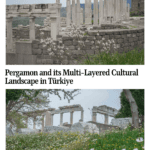Pergamon and its Multi-Layered Cultural Landscape
By Cindy Carlsson
What is Pergamon and its Multi-Layered Cultural Landscape?
As its name indicates, the Pergamon Multi-Layered Cultural Landscape includes more than a single site. Pergamon (Bergama) includes nine separate locations of varying size, importance, and complexity developed during the Hellenistic, Roman, Byzantine, and Ottoman periods.
Disclosure: This article contains affiliate links. Making a purchase through an affiliate link will mean a small commission for this website. This will not affect your price.
Buildings and archaeological sites are the most obvious aspects of the World Heritage designation. However, the UNESCO listing also recognizes ideas that developed here. These include innovations in urban design and sculpture, the invention of parchment, the creation of one of the world’s great libraries, and more.
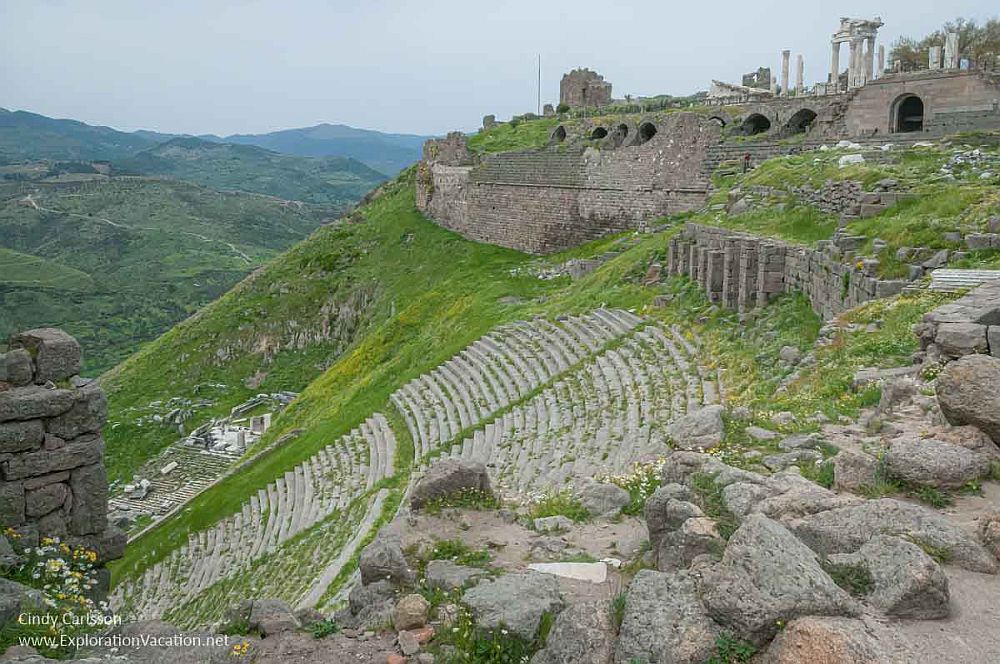
The ancient city of Pergamon
The city of Pergamon includes the acropolis on Kale Hill, other sites on the hillside, the Asclepieion (Asklepion) healing center, and parts of the modern city of Bergama. This is by far the largest part of the World Heritage site.
Pergamon was founded as the capital of the Hellenistic Attalid Dynasty in the 3rd century BC. The hilltop site included a sophisticated street layout and some of the finest architecture of the Hellenistic period, including the steepest theatre of the time, the great Altar of Pergamon, a system of pressurized water pipelines, and more.
Under the Romans, Pergamon became a very large city that continued to use existing structures and built equally grand new ones, including the Asclepieion and the Trajan Temple.
The city shrunk during the Byzantine period, although building material from earlier, abandoned structures was often reused. Later, under the Ottomans, a whole range of urban structures and infrastructure were built in Bergama. All of this resulted in a city that includes a mix of architectural elements that go back to the original Hellenistic city.
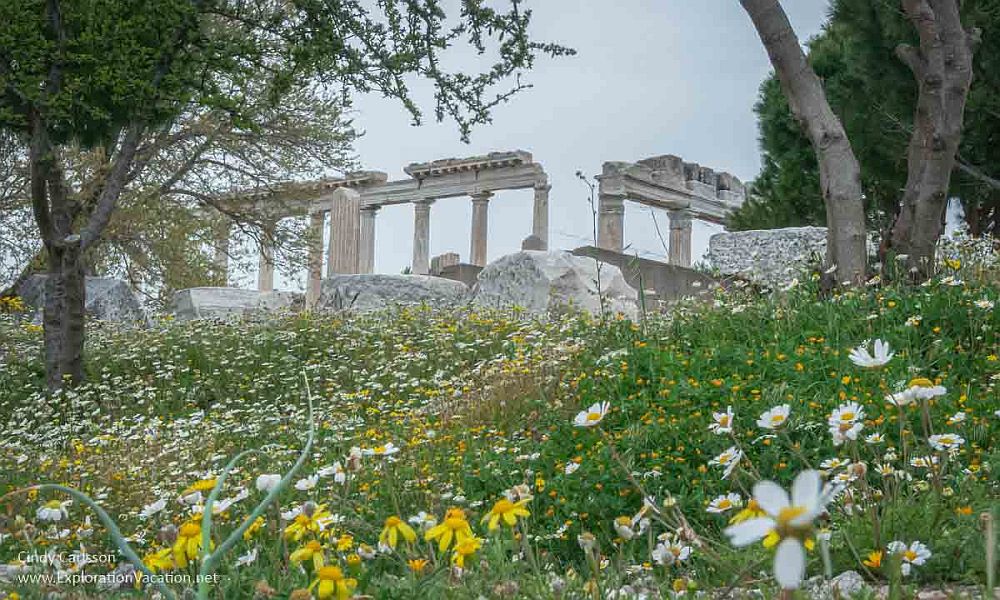
Kybele (Cybele) Sanctuary at Kapikaya
This rustic rock-cut temple is located on a steep summit about 6 km (4 miles) from Pergamon. It’s dedicated to the mother goddess Kybele who was worshipped in natural settings like this.
Circular burial mounds (tumulus)
The World Heritage designation includes seven burial mounds from the Hellenistic period. These are located on the plain below Kale Hill. They range from relatively nondescript mounds to truly monumental earthen structures. The largest of these is Yigma Tepe Tumulus, which has a diameter of 158 meters (518 feet) and a height of 32 meters (over 100 feet). It’s among the largest burial mounds in the eastern Mediterranean. Only a few have been excavated. Most are unmarked and inaccessible.
Why is Pergamon a UNESCO World Heritage site?
Pergamon is important for its urban plan, the beauty of its monuments, and its role as a cultural, scientific, and political center during the Hellenistic and Roman periods. UNESCO says “The building of Pergamon into the slopes at the top of Kale Hill, exploiting the topography with manmade terraces and grand monuments dominating the surrounding plain, is a masterpiece of Hellenistic and Roman urban planning and design.” They add “Pergamon is associated with important people, schools, ideas and traditions concerning art, architecture, planning, religion and science.”
But it’s also important as an example of change over time, as the Romans built on the Hellenistic city followed by the Byzantines and the Ottomans up through the present day. Evidence of all of these cultures can be seen within the city today.
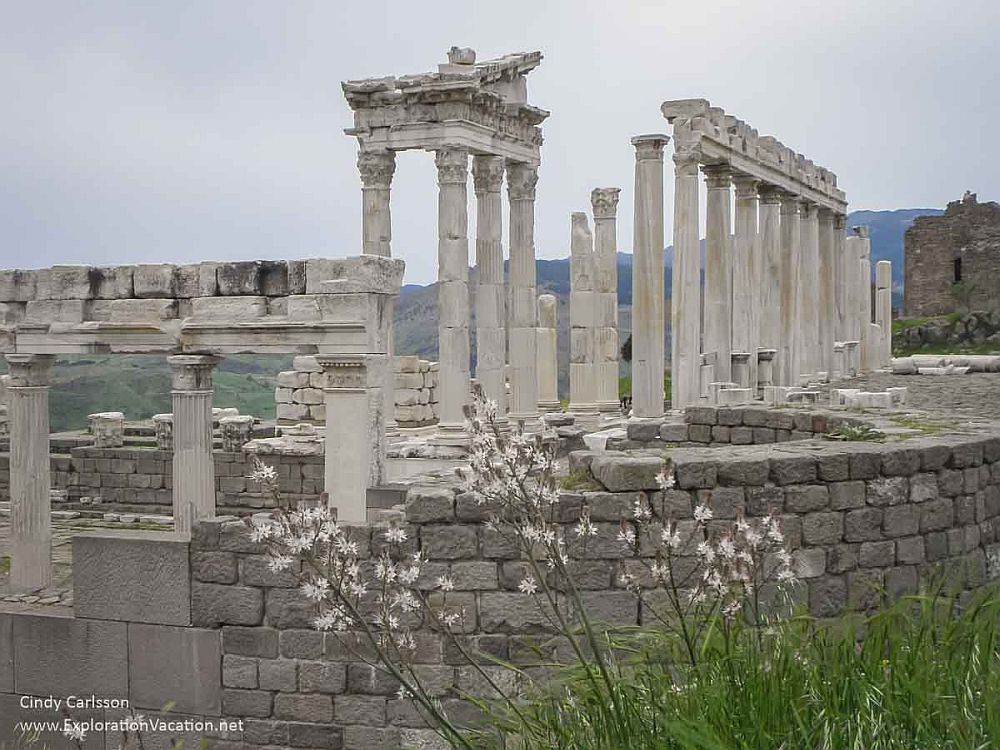
What can you expect on a visit to Pergamon?
Most tourists only visit the Hellenistic and Roman sites on Kale Hill. (Easily reached via an unexpectedly modern gondola.) These are the most important and visually interesting sites at Pergamon, as the remains of the Hellenistic theater, gymnasium, and the Roman Temple of Trajan are striking and archeologically important.
However, the site’s most accomplished structure, the magnificent Altar of Pergamon (the Altar of Zeus) can’t be seen here. It resides in the Pergamon Museum, part of the Museum Island World Heritage site in Berlin. And although the acropolis is noted for both its fabulous architecture and the street layout that highlighted the architecture, today’s visitors really don’t have a good sense of how the site would have looked to ancient visitors. But it’s a lovely, peaceful, and fascinating place to explore.
Far fewer visitors get to the Asclepieion Sanctuary. Begun during the Hellenistic period, this temple of healing became very famous during the Roman period. The site is smaller, more intimate, and seldom crowded. Signage explains the treatments offered here, but it’s also a pleasant spot to just get lost in time for a bit. And it’s a little easier to see how it all fit together.
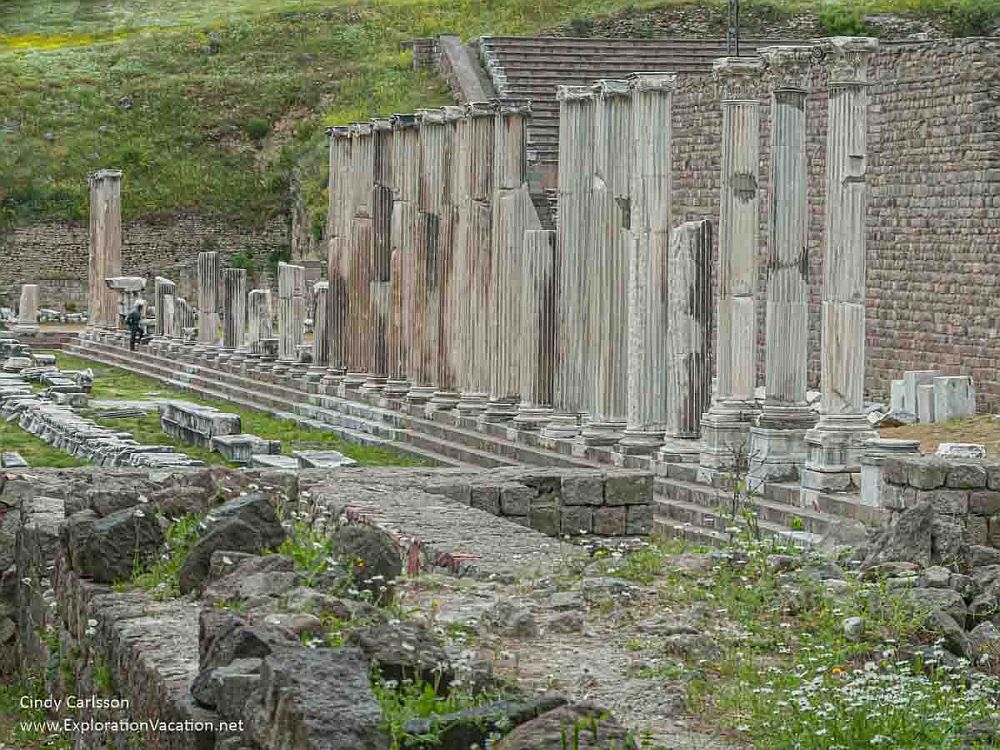
Within modern Bergama, the massive red-brick Serapis Temple (the Red Basilica or the Red Hall) is hard to miss. It’s a site that clearly shows the city’s change over time, as parts of this massive structure went from a Roman-era temple dedicated to an Egyptian god to a Christian basilica under the Byzantines and a mosque under the Ottomans.
Some Ottoman buildings are also obvious even on a casual drive through the city. Along with traditional Ottoman civic buildings and private homes, the city is filled with buildings that incorporate bits of ancient ruins. However, these are generally much harder to spot. Most are privately owned, many are in poor condition, and little information about them is available for visitors.
The situation is similar for visitors interested in seeing and learning more about the burial mounds, many of which are well within the city. The largest are easy to spot, but they really aren’t tourist sites.
Is Pergamon and its Multi-Layered Cultural Landscape worth visiting?
If you’re in this part of Turkey, it’s very worth setting aside a few hours to a half day or more to explore Pergamon.
However, if you must choose between Pergamon and the nearby Ephesus World Heritage site, choose Ephesus. It’s a more important site with much more to see. But Pergamon is interesting, has some unusual features, and is a very pleasant place to visit. Pergamon feels more like rambling through a park with interesting ruins and sculpture than touring an archaeological site. A visit here is both far more relaxing and far less crowded than Ephesus!
Because of its lovely setting and picturesque ruins, Pergamon’s acropolis and Asclepieion should appeal to a wide range of visitors. Most will probably find a couple of hours adequate to see the acropolis. Add another hour for the Asclepieion. Add a little more time to visit the museum.
Visitors interested in tracking down Bergama’s historic Ottoman buildings or some of the buildings that reuse ancient materials can easily spend another hour exploring the historic areas of modern Bergama.
Tips for visiting Pergamon and its Multi-Layered Cultural Landscape
It costs extra to take the gondola, but the views are great. Only take it up, though, as the walk down is pretty easy and passes sights you will miss otherwise. (You can also drive up, but what fun is that?)
The ground around the acropolis can be quite uneven and some areas require a bit of a climb up/down the hillside.
Bring water.
Bring a hat and sunscreen if you are visiting during hot weather.
If you are interested in buying a Turkish carpet, Bergama has long been known for its fine carpets and there are lots of carpet shops in the area.
Use the map below to find accommodations in Bergama:
Where is the Pergamon UNESCO site?
The Pergamon UNESCO World Heritage site is located in the city of Bergama near Turkey’s Aegean Coast. The nearest major city is Izmir. Flights into Izmir are available from across Europe through the city’s Adnan Mende Airport.
- From Izmir, Bergama is 110 km (70 miles) north and slightly inland. Driving time between the two is about 1½ hours. Bus service is available, but regular buses don’t go into Bergama’s city center – look for the Metro Turizm counter in the bus station to find one that does. Or you can sign up for a day tour from Izmir.
- Bergama is 185 km (115 miles) or about a 2½ hour drive north of Ephesus via Izmir.
- Istanbul is just under 400 km (250 miles) and 4½ hours from Bergama. If you’re pressed for time, this one-day tour includes the short flight from Istanbul.
From the center of Bergama, the most popular Pergamon sites (and the cable car that goes to the acropolis) are within walking distance. However, the sites aren’t near each other. If you don’t have your own vehicle, you’ll probably want a taxi to do more than a couple of sites.
Don’t want to use the gondola? Take a taxi or drive up to the acropolis area. Parking is available for a fee.
Locate all nine Pergamon sites using the GIS coordinates on the UNESCO website. However, the sites of interest to most travelers are all located within the historic city of Pergamon, including the acropolis, Asclepieion, Red Basilica, and a variety of Byzantine and Ottoman buildings in the modern city of Bergama.
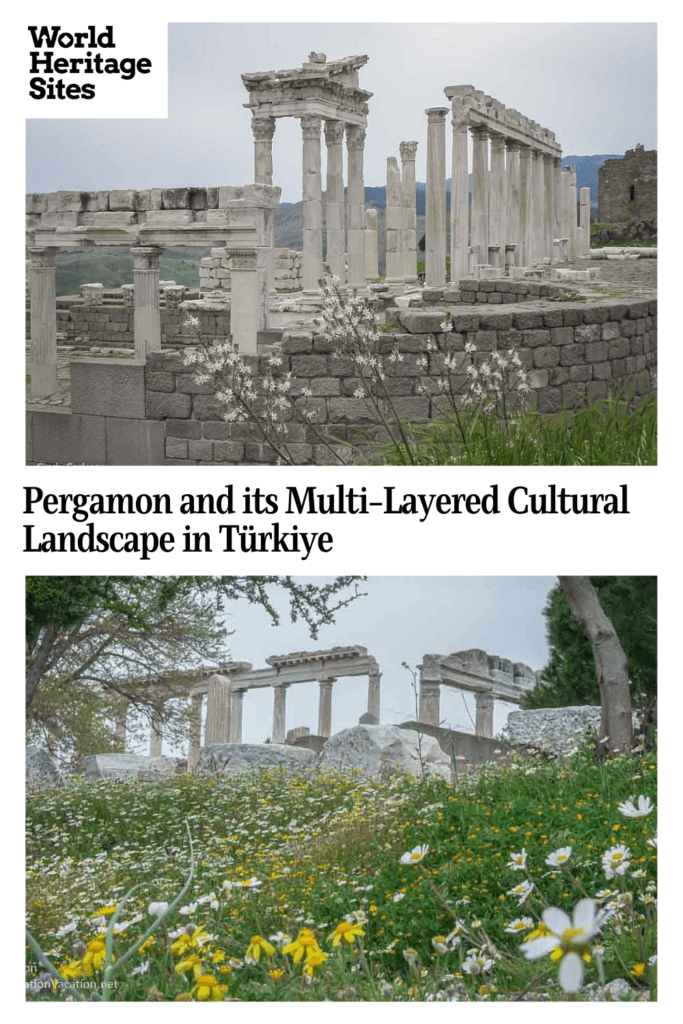
For more information about Pergamon and its Multi-Layered Cultural Landscape, opening hours, and admission fees, see the official websites for various components: Acropolis, Asklepion, Basilica, and the Bergama Museum.
Have you been to Pergamon? If so, do you have any additional information or advice about this UNESCO World Heritage site? Please add your comments below!

